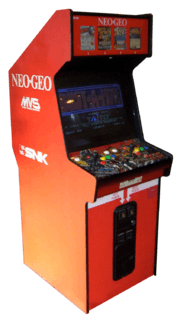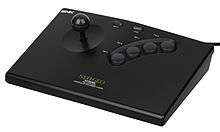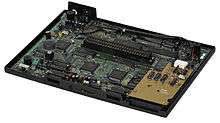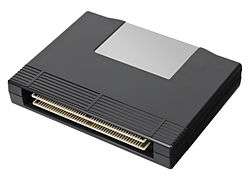Neo Geo (system)
The Neo Geo (Japanese: ネオジオ, Hepburn: Neojio), stylised as NEO•GEO, also written as NEOGEO, is a cartridge-based arcade system board and fourth-generation home video game console released on April 26, 1990, by Japanese game company SNK Corporation. It was the first system in SNK's Neo Geo family. The Neo Geo was marketed as 24-bit; its CPU is technically a 16/32-bit 68000-based system with an 8/16-bit Z80 coprocessor, while its GPU chipset has a 24-bit graphics data bus.
 | |
  Neo Geo AES console (top) and 4-slot MVS arcade cabinet (bottom) | |
| Manufacturer | SNK Corporation |
|---|---|
| Product family | Neo Geo |
| Type | Arcade system board Home video game console |
| Generation | Fourth generation |
| Release date | [1]
Neo Geo Multi Video System Neo Geo Rental System/Neo Geo Advanced Entertainment System |
| Introductory price | US$649.99 |
| Discontinued | 1997 (hardware) 2004 (software) 2007 (technical support) |
| Units sold | 1 million |
| Media | ROM cartridge |
| CPU | Motorola 68000 @ 12MHz, Zilog Z80A @ 4MHz |
| Memory | 64KB RAM, 84KB VRAM, 2KB Sound Memory |
| Storage | Memory card |
| Display | 320×224 resolution, 4096 on-screen colors out of a palette of 65536 |
| Sound | Yamaha YM2610 |
| Power | 8 W older Systems 5 W newer Systems |
| Dimensions | 325 × 237 × 60 mm |
| Successor | Neo Geo CD (1994) Hyper Neo Geo 64 (1997) |
The Neo Geo originally launched as the MVS (Multi Video System) coin-operated arcade machine. The MVS offers owners the ability to put up to six different cartridges into a single cabinet, a unique feature that was also a key economic consideration for operators with limited floorspace, as well as saving money long-term.[2] With its games stored on self-contained cartridges, a game cabinet can be exchanged for a different game title by swapping the game's ROM cartridge and cabinet artwork. A home console version was also made, called AES (Advanced Entertainment System). It was originally launched as a rental console for video game stores in Japan (called Neo Geo Rental System), with its high price causing SNK not to release it for home use – this was later reversed due to high demand and it came into the market as a luxury console. The AES had the same raw specs as the MVS and had full compatibility, thus managed to bring a true arcade experience to home users.[3] The Neo Geo was revived along with the brand overall in December 2012 through the introduction of the Neo Geo X handheld and home system.[4][5][6][7]
The Neo Geo was a very powerful system when released, more powerful than any video game console at the time, and many arcade systems such as rival Capcom's CPS, which did not surpass it until the CP System II in 1993.[8] The Neo Geo MVS was a success during the 1990s due to the cabinet's low cost, six ROM slots, and compact size. Several successful video game series were released for the platform, such as Fatal Fury, Art of Fighting, Samurai Shodown, The King of Fighters and Metal Slug. The AES had a very niche market in Japan, though sales were very low in the U.S. due to its high price for both the hardware and software; but it has since gained a cult following and is now considered a collectable. Neo Geo hardware production lasted seven years, discontinued in 1997, whereas game software production lasted until 2004,[9] making Neo Geo the longest supported arcade system of all time.[10] The AES console was succeeded by the Neo Geo CD and the MVS arcade by the Hyper Neo Geo 64. As of March 1997, the Neo Geo and the Neo Geo CD combined had sold 980,000 units worldwide.[11] In 2009, the Neo Geo was ranked 19th out of the 25 best video game consoles of all time by video game website IGN.[12]
History

The Neo Geo hardware was an evolution of an older SNK/Alpha Denshi M68000 arcade platform that was used in Time Soldiers in 1987, further developed in the SNK M68000 hardware platform as used for P.O.W.: Prisoners of War in 1988. Contrary to other popular arcade hardware of the time, the SNK/Alpha Denshi hardware used sprite strips instead of the more common tilemap based backgrounds.[13] The Neo Geo hardware was essentially developed by Alpha Denshi's Eiji Fukatsu, adding sprite scaling through the use of scaling tables stored in ROM as well as support for a much higher amount of data on cartridges and better sound hardware.[14][15][16]
The Neo Geo was announced on January 31, 1990 in Osaka, Japan[17] and released on April 26, 1990. [18] Initially, the AES home system was only available for rent to commercial establishments, such as hotel chains, bars and restaurants, and other venues. When customer response indicated that some gamers were willing to buy a US$650 console, SNK expanded sales and marketing into the home console market in 1991.
Neo Geo's graphics and sound are largely superior to other contemporary home consoles, arcades, and even computers such as the Sharp X68000. Unlike earlier systems, the Neo Geo AES was intended to reproduce the same quality of game as the arcade MVS system. The MVS was one of the most powerful arcade units at the time, allowing the game ROM to be loaded from interchangeable cartridges instead of using custom, dedicated hardware cabinets for each game.[19]
Early attempts to port arcade games to home systems had been limited by inferior hardware. In a well-known incident when Pac-Man was ported to the Atari 2600 many visual features of the original game had to be changed to compensate for the lack of ROM space and the hardware struggled when multiple ghosts appeared on the screen creating a flickering effect. The poor performance of the ported Pac-Man is cited as a cause of the video game crash of 1983. [19]
In the United States, the console's debut price was planned to be US$599 and included two joystick controllers and a game: either Baseball Stars Professional or NAM-1975. However, the price was raised and its American launch debuted as the Gold System at US$649.99 (equivalent to $1,220 in 2019). Later, the Gold System was bundled with Magician Lord and Fatal Fury. The Silver System package, launched at US$399.99, included one joystick controller and no pack-in game. Other games were launched at about US$200 and up. At double or quadruple the price of the competition, the console and its games were accessible only to a niche market. Although its high price tag kept it out of the mainstream gaming market, it outlasted the market lifespan of its more popular Nintendo and Sega rivals, and also made a unique niche market for it. In addition, its full compatibility meant that no additional money was being spent on porting or marketing for the AES, since the MVS' success was thus automatically feeding the AES, making the console profitable for SNK.
When realtime 3D graphics became the norm in the arcade industry, the Neo Geo's 2D hardware was unable to do likewise. Despite this, Neo Geo arcade games retained profitability through the mid-1990s,[20] and the system was one of three 1995 recipients of the American Amusement Machine Association's Diamond Awards (which are based strictly on sales achievements).[21] SNK developed a new console in 1994, called the Neo Geo CD. A new arcade was also made in 1997, called Hyper Neo Geo 64. However these two systems had low popularity and only a few games.
Despite the failures of these 3D hardware, and the ceasing of manufacturing home consoles by the end of 1997, SNK continued making software for the original 2D Neo Geo. Despite being very aged by the end of the decade, the Neo Geo continued getting popular releases, such as the critically acclaimed The King of Fighters 2002. The last official game by SNK for the Neo Geo system, Samurai Shodown V Special, was released in 2004, 14 years after the system's introduction.
On August 31, 2007, SNK stopped offering maintenance and repairs to Neo Geo home consoles, handhelds, and games.[22]
The Neo Geo X, an officially licensed device with a collection of Neo Geo games pre-installed, was first released in 2012 by TOMMO Inc. After just one year and a lukewarm reception due to its price and poor quality of the emulation, on October 2nd, 2013, SNK Playmore terminated the license agreement and demanded an immediate cease and desist of distribution and sales of all licensed products.[23]
Reception
In a 1993 review, GamePro gave the Neo Geo a "thumbs up". Though they voiced several criticisms, noting that the system was not as powerful as the soon-to-launch 3DO and had few releases which were not fighting games, they generally praised both the hardware and games library, and recommended that gamers who could not afford the console (which was still priced at $649.99) play the games in the arcade.[24]
Technical details

Each joystick controller is 280mm (width) × 190mm (depth) × 95mm (height) ( 11 × 8 × 2.5 in.) and contains the same four-button layout as the arcade MVS cabinet.
The arcade machines have a memory card system by which a player could save a game to return to at a later time and could also be used to continue play on the SNK home console of the same name.
The arcade version of the video game hardware is often referred to as the "MVS," or Multi Video System (available in 1-slot, 2-slot, 4-slot, and 6-slot variations, differing in the amount of game cartridges loaded into the machine at the time), with its console counterpart referred to as the "AES", or Advanced Entertainment System. Early motherboard revisions contain daughterboards, used to enhance the clarity of the video output.
The MVS and AES hardware can execute identical machine code. Owners can move EPROMs from one type to the other, and the game will still run. The program specifics for both MVS and AES game options are contained on every game ROM, whether the cartridge is intended for home or arcade use. However, the arcade and home cartridges do have a different pinout. They were designed this way to prevent arcade operators from buying the cheaper home carts and then using them in arcades. It has been found that in a few home version games, one could unlock the arcade version of the game by inputting a special code.
ROM sizes and startup screens
The original specification for ROM size is up to 330 megabits, hence the system displaying "Max 330 Mega Pro-Gear Spec" upon startup. While no technical advances were required to achieve it, some games over 100 megabits, such as Top Hunter, followed this screen by displaying an animation proclaiming "The 100Mega Shock!". The original ROM size specification was later enhanced on cartridges with bank switching memory technology, increasing the maximum cartridge size to around 716 megabits. These new cartridges also cause the system to display "Giga Power Pro-Gear Spec" upon startup or during attract mode, indicating this enhancement.
 The 100Mega Shock!
The 100Mega Shock! Giga Power
Giga Power
Specifications

The system uses seven different specialist processors, which divide the workload for the visuals, audio and gameplay.[25]
CPU
- Main CPU processor: Motorola 68000 (often a second sourced version, usually by Toshiba or Hitachi) @ 12 MHz (16/32-bit instructions @ 1.75 MIPS[26])
- CPU co-processor: Zilog Z80 @ 4 MHz (also used as audio controller) (8/16-bit instructions @ 0.58 MIPS[26])
RAM
- Main 68000 RAM: 64 KB (32 KB SRAM ×2)
- Video RAM: 84 KB SRAM
- Main VRAM: 64 KB (32 KB SRAM ×2)
- Palette memory: 16 KB (8 KB SRAM ×2)
- Fast video sprite RAM: 4 KB (2 KB SRAM ×2)
- Z80 sound RAM: 2 KB SRAM
- Battery-backup save NVRAM: 64 KB SRAM
- Zoom look-up table: 128 KB
- Fix layer graphics: 128 KB
- Z80 sound: 128 KB
- 68000 BIOS: 128 KB
Display
The SNK custom video chipset allows the system to draw sprites in vertical strips which are 16 pixels wide, and can be 16 to 512 pixels tall; it can draw up to 96 sprites per scanline for a total of 380 sprites on the screen at a time. Unlike most other video game consoles of its time, the Neo Geo does not use scrolling tilemap background layers. Instead, it has a single non-scrolling tilemap layer called the fix layer, while any scrolling layers rely exclusively on drawing sprites to create the scrolling backgrounds (like the Sega Y Board). By laying multiple sprites side by side, the system can simulate a tilemap background layer. The Neo Geo sprite system represents a step between conventional sprites and tilemaps.[27]
- GPU chipset:[28]
- GPU graphics data bus: 24-bit [31][32]
- Display resolution: 320×224 px (many games only use the centermost 304 px),[27] progressive scan
- Color palette: 65,536 (16-bit) (not RGB565, but RGB666, where the lowest bit of each channel is shared, being common to the three RGB components)[27]
- Maximum colors on screen: 4096 (12-bit)
- Maximum sprites on screen: 380
- Minimum sprite size: 16×16 px
- Maximum sprite size: 16×512 px
- Maximum sprites per scanline: 96
- Maximum sprite pixels per scanline: 1536 px[27]
- Static tilemap plane: 1 (512×256 px fix layer)[27]
- Sprite planes: 3 planes which enable parallax scrolling (large sprites can be chained together to make objects that function similarly to tilemap backgrounds) [27]
- Aspect ratio: 4:3
- A/V output: RF, composite video/RCA audio, RGB (with separate 21 pin RGB cable FCG-9, or European standard RGB SCART cable).
Sound
The onboard Yamaha YM2610 sound chip gives the system 15 channels of sound.
- Sound chip: Yamaha YM2610
- 4 concurrent FM channels (voices), four operators per channel
- 3 SSG channels
- 1 programmable noise channel
- ADPCM-A: 6 ADPCM channels, 18.5 kHz sampling rate, 12-bit audio depth[33]
- ADPCM-B: 1 ADPCM channel, 1.85–55.5 kHz sampling rate, 16-bit audio depth[33]
- 2 interval timers
- 1 low frequency oscillator (LFO)
- Sound/Work RAM: 2KB
- Sound ROM: 128 KB on-board (only less than 32 KB used), up to 512 KB sound ROM on cartridges
Other
- Power
- Source: separate DC 5 V (older systems) and DC 9 V adapter (newer systems).
- Consumption: 8 W older Systems, 5 W newer Systems
- Dimensions
- Console: 325 mm (width) × 237 mm (depth) × 60 mm (height).
- Controller: 280 mm (width) × 190 mm (depth) × 95 mm (height).

- Console storage
- Removable memory card: 2KB or 68-pin JEIDA ver. 3 spec memory. Any 68-pin memory that fits the JEIDA version 3 spec will work.
- Arcade storage
- Removable memory card: 68-pin. Cartridge is composed of 2 PCBs.[34]
Legacy
The Neo Geo is the first home game console to feature a removable memory card for saved games.
The GameTap subscription service has included a Neo Geo emulator and a small library of Neo Geo games. In 2007 Nintendo announced that Neo Geo games would appear on the Wii's Virtual Console,[35][36][37][38] starting with Fatal Fury: King of Fighters, Art of Fighting, and World Heroes. Neo Geo games were released through Xbox Live Arcade and PlayStation Network, including Fatal Fury Special, Samurai Shodown II, Metal Slug 3, Garou: Mark of the Wolves and The King of Fighters '98. Many Neo Geo games were released on the PlayStation 4, Xbox One, and Nintendo Switch through the Arcade Collection Archives (ACA) service.
Homebrew activity began after the console's discontinuation, both by noncommercial hobbyists and commercially.[39]
Neo Geo has a community of collectors. Because of the limited production runs received by cartridges amongst the sizable available arcade library, some of the rarest Neo Geo games can sell for well over $1,000. The most valuable game is the European AES version of Kizuna Encounter. The MVS market provides a cheaper alternative to the expensive and rare home cartridges, and complete arcade kits are priced at a premium.[40] It is also possible to play the MVS cartridges, which generally cost much less, on the AES home system through the use of adapters.
On June 9, 2018, SNK announced the Neo Geo Mini, a miniature semi-portable arcade cabinet which features 40 built-in SNK titles, would be released on July 24, 2018 in Japan. The games are the AES versions, but the Neo Geo Mini features a system which allows players to save and load the game at any time. Neo Geo Mini also can connect to a TV screen with a separately sold HDMI cable. It has a headphone jack and two ports for external Neo Geo mini Pad controllers (also sold separately), which are a re-design of the Neo Geo CD controllers. SNK also announced a Neo Geo Mini International Version, which contains the same features as the Japanese Neo Geo Mini but with 14 titles changed.
See also
References
- "Neo-Geo Hardware Specification". Archive.org. Retrieved 2014-07-22.
- "SNK Neo-Geo 101: A Beginner's Guide - RetroGaming with Racketboy". 20 May 2011.
- Andy Slaven (2002). Video Game Bible, 1985-2002. Trafford Publishing. pp. 338–. ISBN 978-1-55369-731-2.
- Plunkett, Luke. "The "New" Neo Geo Handheld Goes on Sale Very Soon". Kotaku. Retrieved 16 March 2012.
- Dutton, Fred. "New NeoGeo handheld confirmed". Eurogamer. Retrieved 16 March 2012.
- "NEOGEO X GOLD ENTERTAINMENT SYSTEM Announced for Worldwide Distribution". RetroGamingRoundup. 13 August 2012.
- "New console out today as NEO GEO X hits EU/US". Games Radar. Future Publishing. December 18, 2012. Retrieved January 28, 2013.
- "Neo Geo History". Neo Geo, Arcade & Retro Games.
- Hirohiko Niizumi, , GameSpot, July 23, 2004, Accessed June 8, 2008.
- "Longest support for an arcade system". Guinness World Records.
- Consoles +, issue 73
- "NeoGeo is number 19". IGN. Retrieved 2012-01-26.
- "MAME - BryanMcPhail.com". www.bryanmcphail.com.
- "ADK会社案内". 3 August 2001. Archived from the original on 3 August 2001.
- "ADK". www.neo-geo.com.
- "100,000 + 1 things you never new about neo - Page 9". www.neo-geo.com.
- "Mortal Shang - Neo-Geo". Mortal Shang. Retrieved 2012-01-26.
- "Arcade Gear - Neo Geo". MArcade Gear. Archived from the original on 2016-10-07. Retrieved 2015-07-11.
- Nicoll, Benjamin (2015). "Bridging the Gap: The Neo Geo, the Media Imaginary, and the Domestication of Arcade Games". Games and Culture. doi:10.1177/1555412015590048.
- Webb, Marcus (November 1995). "Arcadia". Next Generation. Imagine Media (11): 26.
Basically, SNK's Neo Geo system has proved the existence of a die-hard market for lower-cost videogames in arcades ...
- "And the Winner Is...". Next Generation. No. 17. Imagine Media. May 1996. p. 21.
- "No Love: SNK Stop Neo Geo Support". Archived from the original on 17 July 2012.
- "SNK terminates Neo Geo X Gold licensing, Tommo required to cease production". Engadget.
- "System Shopper". GamePro (63). IDG. December 1993. pp. 46–49.
- Elizabeth Olson, "Neo Geo: The Shape of Things to Come?", Game Informer, issue 2 (November-December 1991), page 14
- "Lud's RetroComputing Info". drolez.com.
- MacDonald, Charles. "Neo*Geo MVS Hardware Notes". Retrieved 2012-01-26.
- "Archived copy". Archived from the original on 2015-12-10. Retrieved 2014-09-26.CS1 maint: archived copy as title (link)
- "Category:Chips - NeoGeo Development Wiki". wiki.neogeodev.org.
- "SNK Neo Geo AES". ConsoleGen.
- P bus, Neo Geo Development
- LSPC2-A2, Neo Geo Development
- "YM2610 - NeoGeo Development Wiki". wiki.neogeodev.org.
- "Repairing a Neo-Geo MVS cartridge?". June 2007. Retrieved 2011-12-14.
- "The Return of the NeoGeo". Wii.ign.com. Retrieved 2012-01-26.
- "Virtual Console: NeoGeo Games Coming To Virtual Console". Kotaku.
- "Neo Geo Comes to European Virtual Console". Nintendo of Europe. 1 October 2007. Archived from the original on 2 October 2007. Retrieved 15 December 2009.
- "Wii-kly Update: Three New Classic Games Added to Wii Shop Channel". Nintendo of America. 8 October 2007. Archived from the original on 11 October 2007. Retrieved 15 December 2009.
- "NG:Dev.Team, a third party NeoGeo publisher". Retrieved 23 April 2015.
- "Neo Geo AES price guide". Neo-geo.com. Retrieved 2012-01-26.
External links
| Wikimedia Commons has media related to Neo-Geo. |